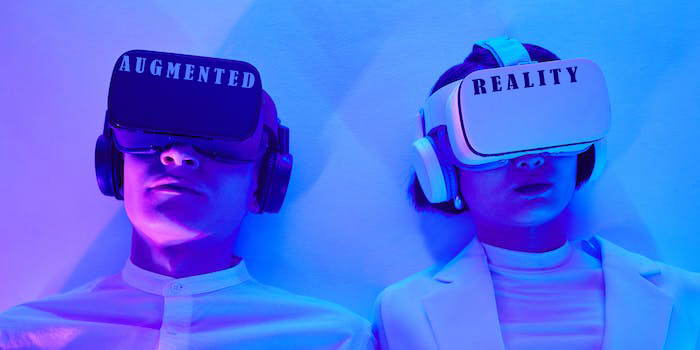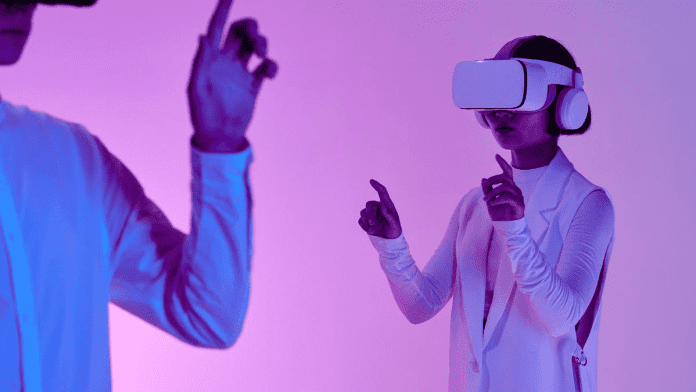Table of Contents
AR in Education

Augmented reality (AR) holds immense potential in transforming education by enhancing traditional teaching methods and creating immersive and interactive learning experiences. Here are some key applications and benefits of augmented reality in education:
Visualizing Complex Concepts: AR enables students to visualize complex ideas and concepts in a more tangible and interactive way. By overlaying digital content onto the real world, students can better understand abstract or spatial concepts that may be challenging to grasp through traditional methods.
Interactive Learning Experiences: AR brings textbooks, worksheets, and learning materials to life by adding interactive elements. Students can use their mobile devices or AR glasses to engage with digital content, animations, 3D models, and simulations, making the learning process more engaging and enjoyable.
Virtual Field Trips: With AR, students can embark on virtual field trips without leaving the classroom. They can explore historical landmarks, natural wonders, or even visit planets in the solar system. This immersive experience broadens students’ understanding of different subjects and cultures.
Simulations and Hands-On Learning: AR allows students to simulate experiments, practice skills, or perform virtual lab work. For example, science students can conduct virtual chemistry experiments, anatomy students can examine 3D models of the human body, and engineering students can design and test structures in a virtual environment.
Personalized Learning: AR can adapt to individual student needs, providing personalized learning experiences. By tracking and analyzing students’ progress and performance within AR applications, educators can offer targeted feedback and tailor content to address specific areas of improvement.
Collaboration and Teamwork: AR fosters collaboration and teamwork by allowing multiple students to interact with shared AR content simultaneously. They can collaborate on projects, solve problems together, or contribute to virtual group activities, promoting communication and cooperation skills.
Accessibility and Inclusivity: AR can make education more accessible and inclusive for students with different learning styles or disabilities. By offering visual and interactive elements, AR accommodates diverse learners and provides alternative ways of understanding information.
Real-world Application and Career Readiness: AR can bridge the gap between classroom learning and real-world applications. By simulating workplace scenarios and industry-specific tasks, students can gain practical skills and better prepare for future careers.
Engagement and Motivation: The interactive and immersive nature of AR tends to increase student engagement and motivation. By adding an element of fun and excitement, AR makes learning more enjoyable, leading to improved knowledge retention and academic performance.
Content Creation by Students: AR empowers students to create their own augmented reality content, fostering creativity, critical thinking, and problem-solving skills. Students can design AR experiences, develop content, and share their creations, further enhancing their understanding of the subject matter.
AR in Healthcare
Augmented reality (AR) technology offers significant potential for transforming healthcare by providing innovative tools and solutions. Here are some key areas where AR is being utilized in healthcare:
Surgical Planning and Navigation: AR can assist surgeons in planning and performing complex procedures. By overlaying patient-specific data, such as CT or MRI scans, onto the surgeon’s field of view, AR enables real-time visualization of anatomical structures and critical information during surgeries. This aids in precise incisions, reducing the risk of complications and improving patient outcomes.
Medical Education and Training: AR can enhance medical education by creating interactive and immersive learning experiences. Medical students can use AR to visualize and study anatomical structures, practice surgical techniques, and simulate patient scenarios. It provides a safe and realistic environment for hands-on training, allowing for better understanding and skill development.
Real-Time Assistance and Guidance: During surgical procedures or clinical examinations, AR can provide real-time guidance and assistance to healthcare professionals. Relevant patient data, such as vital signs, lab values, or medication information, can be overlaid onto the surgeon’s field of view, enabling quick access to critical information without diverting attention from the patient.
Telemedicine and Remote Consultations: AR technology can enhance telemedicine and remote consultations by overlaying virtual objects or annotations onto live video streams. This allows remote healthcare professionals to provide guidance and expertise to on-site clinicians or patients, improving the quality and accuracy of remote care.
Rehabilitation and Physical Therapy: AR is being used in rehabilitation and physical therapy to create interactive exercises and gamified experiences. By overlaying virtual objects or instructions onto the patient’s real-world environment, AR can motivate and guide patients during their rehabilitation journey, making exercises more engaging and effective.
Mental Health Treatment: AR has potential applications in mental health treatment, particularly for anxiety disorders and phobias. By creating virtual environments that simulate stressful situations, individuals can be exposed to their fears in a controlled and safe manner. AR-based exposure therapy can help patients gradually overcome their anxieties and phobias.
Medical Device Training and Maintenance: AR can assist in the training of healthcare professionals on complex medical devices and equipment. It can provide step-by-step instructions, highlight critical components, or overlay relevant data onto the device’s physical structure. Additionally, AR can aid in maintenance tasks by offering real-time diagnostic information and guiding technicians through repairs or troubleshooting.
Patient Education and Empowerment: AR can play a significant role in patient education by providing visual representations and interactive content to explain medical conditions, treatment options, and surgical procedures. This empowers patients to make informed decisions about their healthcare and better understand their diagnoses, leading to improved patient outcomes and satisfaction. Otips.xyz
Gaming has embraced AR technology, opening up new possibilities for interactive entertainment. Through AR, gamers can experience virtual objects and characters in their own environments, blurring the line between the real and virtual worlds. Popular games like Pokémon Go have demonstrated the broad appeal and potential of AR in the gaming industry.
AR in Gaming


Mobile AR Games: AR technology has been predominantly adopted in mobile gaming. Games like Pokémon Go reached global popularity by allowing players to capture virtual creatures in the real world using their smartphones. These games overlay digital content onto the real-world environment, creating an immersive and gaming experience.
Location-based AR: Location-based AR games utilize GPS technology to create gaming experiences that are specific to real-world locations. Players can explore their surroundings and interact with virtual objects or characters tied to specific places. This approach enhances exploration, discovery, and social interaction within the game.
Tabletop AR Gaming: Tabletop AR games merge the physical and digital worlds by projecting virtual objects onto a real-world surface, such as a table. Players can interact with these virtual objects through touch, gestures, or controllers, bringing traditional board games and puzzles to life.
Mixed Reality Gaming: Mixed reality gaming combines elements of virtual reality (VR) and augmented reality. Players wear headsets that track their movement and overlay virtual objects onto their real-world surroundings. This technology allows users to physically interact with virtual content and creates a highly immersive gaming experience.
Social AR Gaming: AR has introduced social interactions in gaming by enabling multiplayer experiences in the real world. Players can collaborate or compete with friends and other players in shared AR environments. These social interactions can take place locally or remotely, fostering community engagement and friendly competition.
Gamification of Real-world Activities: AR has gamified real-world activities by adding interactive elements and rewards. For example, fitness apps use AR to turn exercise routines into fun and engaging games, encouraging users to reach their fitness goals. AR also enhances learning experiences by transforming educational tasks into interactive challenges.
Integration with Wearable Devices: AR technology has been integrated into wearable devices such as smart glasses, making gaming experiences more convenient and immersive. Wearable AR devices offer hands-free gameplay and provide a more seamless integration of virtual content with the real world.
Advertising and Brand Engagement: AR has been utilized in advertising campaigns and brand engagement initiatives. Brands can create AR experiences that allow users to interact with their products, characters, or virtual environments, increasing brand awareness and customer engagement.
Esports and Spectator Experiences: AR is revolutionizing esports and spectator experiences by overlaying digital information and statistics onto live broadcasts of competitive gaming events. This augmented data enhances viewer engagement and delivers a more informative and interactive watching experience.
User-generated Content: AR empowers users to create and share their own content within gaming experiences. Players can design and customize virtual objects, characters, or levels using AR creation tools, fostering creativity, and expanding the possibilities in gaming.
AR in Marketing


AR has transformed marketing strategies by allowing brands to engage consumers in innovative ways. With AR-enabled mobile apps, customers can virtually try on clothing, visualize furniture in their homes, or preview products before purchasing. This immersive marketing approach enhances customer experiences and influences buying decisions.
Product Visualization: AR allows consumers to visualize products in their real-world environment before making a purchase. By overlaying virtual 3D models of products onto the camera view of their smartphones or tablets, consumers can see how the product would look in their space, try out different colors or styles, and make more informed buying decisions.
Virtual Try-On: AR enables consumers to try on virtual products, such as clothing, accessories, or makeup. By using augmented reality filters or applications, consumers can see themselves wearing different outfits, trying various hairstyles, or experimenting with different makeup looks. This enhances the online shopping experience and reduces the need for physical try-ons.
Interactive Packaging: AR can transform product packaging into an interactive experience. By scanning the packaging with a smartphone or tablet, consumers can unlock additional content, such as videos, games, or special offers. This engages consumers and creates a memorable brand experience.
Location-Based AR Experiences: Brands can use location-based AR experiences to engage with consumers in specific physical locations. For example, businesses can create AR scavenger hunts or treasure hunts in their stores or at events, encouraging customers to explore and interact with their products or services.
Enhanced Print Advertising: AR can bring static print advertisements to life by adding digital content and interactivity. Readers can scan the advertisement with their devices to access additional information, videos, or interactive elements. This extends the reach and impact of traditional print advertising.
Brand Storytelling and Engagement: AR allows brands to tell interactive and immersive stories that resonate with consumers. By overlaying digital content onto the physical world, brands can create engaging narratives, virtual tours, or interactive experiences that capture consumer attention and deepen brand loyalty.
Gamification: AR can turn marketing campaigns into interactive games. By incorporating AR elements into mobile apps, brands can create gamified experiences that offer incentives, rewards, or challenges to consumers. This increases engagement, encourages repeat interactions, and generates buzz around the brand.
Virtual Events and Experiences: AR can enhance virtual events by creating immersive and interactive experiences for attendees. Brands can use AR applications or platforms to enable virtual exhibitions, conferences, or product launches, allowing users to explore visual presentations, engage in Q&A sessions, or network in a virtual environment.
Social Media Filters and Effects: AR has become popular on social media platforms, with filters and effects that overlay virtual objects or modify users’ appearances. Brands can leverage these AR filters to promote their products or campaigns, engage with followers, and increase brand awareness through user-generated content.
Data Analytics and Personalization: AR technology can collect valuable data analytics that provide insights into consumer behavior, preferences, and engagement patterns. This information allows brands to personalize marketing campaigns, target specific demographics, and deliver customized AR experiences.
AR in Retail


Retailers are leveraging AR to enhance the shopping experience both in-store and online. Customers can use AR apps to visualize how furniture or home décor items would look in their space, virtually try on clothes, or receive personalized product recommendations based on their preferences. AR enables retailers to create interactive shopping environments and increase customer satisfaction.
Virtual Try-On: AR allows customers to virtually try on products before making a purchase. For example, in the fashion industry, customers can use AR-enabled apps or mirrors to overlay virtual clothing onto their bodies, providing an immersive virtual fitting experience. This helps customers visualize how products will look on them without having to physically try them on.
Virtual Showrooms: AR enables retailers to create virtual showrooms where customers can browse and interact with products in a digital space. Customers can view and manipulate virtual versions of products in 3D, exploring different variations, colors, and features. This helps customers make more informed purchase decisions by experiencing products in a realistic and interactive way.
Interactive Product Visualization: Through AR, customers can visualize products in their own environment. For instance, furniture retailers can use AR apps to allow customers to place virtual furniture in their homes, enabling them to see how it fits and matches their existing decor. This provides a more immersive and personalized shopping experience.
Product Information and Reviews: AR can provide customers with real-time product information, reviews, and ratings through augmented overlays. By simply scanning a product or its packaging, customers can access enhanced product details, customer reviews, and relevant information, enabling them to make informed purchasing decisions.
In-Store Navigation and Assistance: AR can assist customers in finding products and navigating in physical stores. Retailers can develop AR apps that provide interactive store maps, product locations, and personalized recommendations. This improves the customer experience by reducing search times and enhancing convenience.
Personalized Recommendations: AR-powered recommendation engines can offer personalized product suggestions and recommendations to customers based on their preferences, purchase history, and browsing behavior. By integrating AR into customer profiles and shopping apps, retailers can provide a more tailored and customized shopping experience.
Enhanced Marketing and Advertising: AR can be used to create interactive and engaging marketing campaigns. Retailers can develop AR advertisements that allow customers to interact with virtual models of products or play games related to the brand. AR-powered marketing campaigns attract customer attention, increase brand awareness, and drive higher engagement.
Remote Shopping and Consultations: AR facilitates remote shopping experiences and consultations by enabling virtual interactions between customers and retail associates. Customers can use AR-enabled apps or devices to communicate with sales representatives who can provide personalized assistance, product demonstrations, and recommendations, regardless of physical distance.
Virtual Storytelling and Brand Engagement: AR allows retailers to create immersive storytelling experiences that engage customers and strengthen brand connections. Through augmented reality, retailers can bring products to life with interactive virtual content, animations, and narratives, enhancing customer engagement and brand loyalty.
Data Analytics and Insights: AR-powered retail solutions generate valuable data and insights on customer behavior, preferences, and engagement. Retailers can analyze this data to gain a deeper understanding of customer needs and optimize their product offerings and marketing strategies accordingly.


